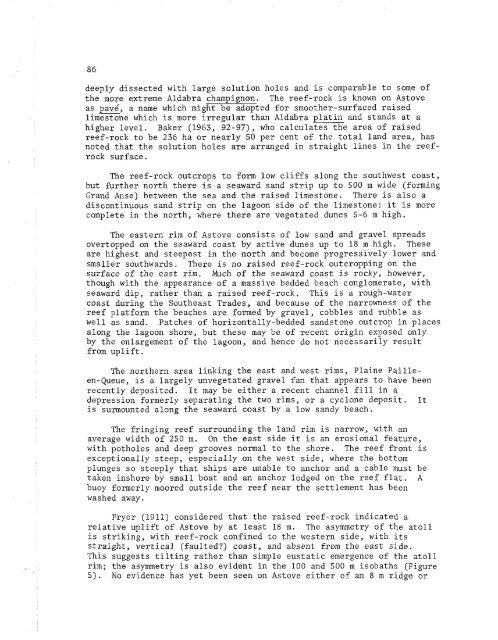ATOLL RESEARCH BULLETIN - Smithsonian Institution
ATOLL RESEARCH BULLETIN - Smithsonian Institution
ATOLL RESEARCH BULLETIN - Smithsonian Institution
Create successful ePaper yourself
Turn your PDF publications into a flip-book with our unique Google optimized e-Paper software.
deeply dissected with large solution holes and is comparable to some of<br />
the more extreme Aldabra champignon. The reef-rock is known on Astove<br />
as @, a name which might be adopted for smoother-surfaced raised<br />
limestone which is more irregular than Aldabra platin and stands at a<br />
higher level. Baker (1963, 92-97), who calculates the area of raised<br />
reef-rock to be 236 ha or nearly 50 per cent of the total land area, has<br />
noted that the solution holes are arranged in straight lines in the reef-<br />
rock surface.<br />
The reef-rock outcrops to form low cliffs along the southwest coast,<br />
but further north there is a seaward sand strip up to 500 m wide (forming<br />
Grand Anse) between the sea and the raised limestone. There is also a<br />
discontinuous sand strip on the lagoon side of the limestone: it is more<br />
complete in the north, where there are vegetated dunes 5-6 m high.<br />
The eastern rim of Astove consists of low sand and gravel spreads<br />
overtopped on the seaward coast by active dunes up to 18 m high. These<br />
are highest and steepest in the north and become progressively lower and<br />
smaller southwards. There is no raised reef-rock outcropping on the<br />
surface of the east rim. Much of the seaward coast is rocky, however,<br />
though with the appearance of a massive bedded beach conglomerate, with<br />
seaward dip, rather than a raised reef-rock. This is a rough-water<br />
coast during the Southeast Trades, and because of the narrowness of the<br />
reef platform the beaches are formed by gravel, cobbles and rubble as<br />
well as sand. Patches of horizontally-bedded sandstone outcrop in places<br />
along the lagoon shore, but these may be of recent origin exposed only<br />
by the enlargement of the lagoon, and hence do not necessarily result<br />
from uplift.<br />
The northern area linking the east and west rims, Plaine Paille-<br />
en-Queue, is a largely unvegetated gravel fan that appears to have been<br />
recently deposited. It may be either a recent channel fill in a<br />
depression formerly separating the two rims, or a cyclone deposit. It<br />
is surmounted along the seaward coast by a low sandy beach.<br />
The fringing reef surrounding the land rim is narrow, with an<br />
average width of 250 m. On the east side it is an erosional feature,<br />
with potholes and deep grooves normal to the shore. The reef front is<br />
exceptionally steep, especially on the west side, where the bottom<br />
plunges so steeply that ships are unable to anchor and a cable must be<br />
taken inshore by small boat and an anchor lodged on the reef flat. A<br />
buoy formerly moored outside the reef near the settlement has been<br />
washed away.<br />
Fryer (1911) considered that the raised reef-rock indicated a<br />
relative uplift of Astove by at leas-t 18 m. The asymmetry of the atoll<br />
is striking, with reef-rock confined to the western side, with its<br />
straight, vertical (faulted?) coast, and absent from the east side.<br />
This suggests tilting rather than simple eustatic emergence of the atoll<br />
rim; the asymmetry is also evident in the 100 and 500 m isobaths (Figure<br />
5). No evidence has yet been seen on Astove either of an 8 m ridge or

















